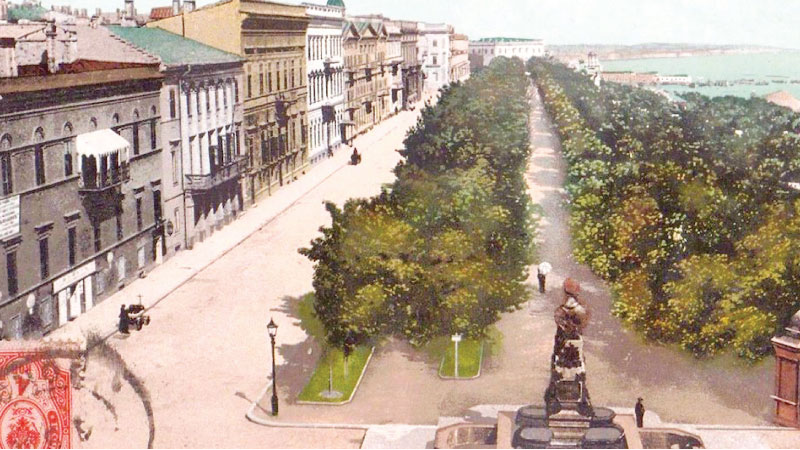Odessa is a young city by European standards, but what it lacks in historical gravitas it makes up for with its splendid architectural bones and worldliness. Cosmopolitan from its inception, its life began when Neapolitan officer General Don Jose de Ribas seized a Tatar-built fort, Hadji Bey, from the Turks in 1789. His conquest complete, de Ribas asked Catherine the Great if she liked the Grecian name Odessos. She did, but only once she’d feminized it to “Odessa.”
Subpar roads connecting Odessa to Moscow played to the city’s advantage, with the port offering easier access to Europe, the Mediterranean and Aegean Seas via the Bosphorus and the Dardanelles Strait. From the outset outward looking, Odessa refused to rely on the empire in the north, instead always looking to the sea for its fortune. This benefited its inhabitants greatly. De Ribas reveled in the world that began to open up, one that allowed small pleasures like drinking European wine and eating mastic-laced sweets.
De Ribas wanted an upgraded version of his home city of Naples for Odessa but it wasn’t until Armand-Emmanuel du Plessis (better known as the duc de Richelieu), a man born into French nobility, became governor of Odessa in 1803 that new roads, schools, theaters and city planning took hold. It took his successor, the Paris-born Count Alexandre de Langeron, to make Odessa the city it became. Under him, in 1817, the city gained free port status, allowing the stockpiling of imported goods without customs duties. Then the fun began.
Ships brought ashore goods as exotic as their origins: bulbous jars of Jamaica rum, oranges from Jerusalem, tins of sardines, bolts of Japanese silks, pots of cayenne pepper, bags of coffee and cocaine, boxes of cigars and tobacco from Virginia. Salt beef and furs left Odessa’s docks, while from Constantinople (Istanbul) arrived cargoes of nuts and olives. Silk came from Florence and wine from Spain. Trade ships, from Newcastle, Port Said and Marseille, gathered in the harbor, sometimes three hundred at once. Contraband flooded in, paid for in all manner of currencies, lining the pockets of shipping brokers and filling the stomachs of porters. In Yiddish, “living like God in Odessa,” became slang for having a good time. The city became a vast emporium.
Thriving, and no longer a remote outpost, the city was now a commercial centre full of promise, optimism and opportunity. As Europe’s trading partner, Odessa became a Black Sea gateway to the world, attracting hundreds of smugglers and stevedores, netters, dockers and deckhands, all drawn by the sugar-rush of fast cash and the freedom that only a port city can offer. To the workers, the city was “Odessa mama,” as she pleased, fed and provided. Anyone with two hands and the ability to work would be welcomed, no checks required. Everyone mixed.
Bloated with cash, the city’s population swelled. French-speaking aristocrats, bohemian nobility and merchants shared dining rooms with Greeks (the first bakers in the city, initially welcomed for their maritime skills and making up 10 percent of the population by 1795), Bulgarians, Turks, Tatars and Jews. This colorful patchwork population contributed hugely to Odessa’s psyche of shrewdness, style and humor. In well-heeled Cafe Fanconi waiters dressed in frock coats, serving pike caviar smeared on black bread, while in seedier subterranean bars, flagons of beer-like kvas poured from metal kegs in cellars serving as underground fridges. Lemon and orange scented the city in the late 1800s as citrus sellers pushed their carts through the streets. Most importantly of all, cargoes of wheat were shipped out in huge quantities from Odessa, making the Russian Empire—for a while at least—Europe’s breadbasket.
It’s unclear how, despite its abiding soul, a place like this can survive at all. Largely emptied out. Stranded. A ghost.
Journalist and author Aleksandr Kuprin, writing of going out with fishermen to catch mackerel in 1905, almost a century on after Odessa gained free port status, captured the industrious atmosphere:
Sailors of various nations, fishermen, stokers, merry ships’ boys, harbor thieves, machinists, workers, boatmen, dockers, divers, smugglers—they were all young, healthy, and steeped in the strong odor of sea and fish; they understood hard work . . . and valued above all strength, prowess and the sting of strong language.
Today, decay—in equal measure romantic and tragic—fills the historic center that hugs Odessa’s port. The neoclassical, pseudo-Gothic and Art Nouveau buildings are handsome but threadbare—the stuff of Russian novels—decorated with ornate moldings, fine arches and columns. Others are too sad for words, crumbling and abandoned, with boarded-up windows, their once grand balconies replaced with cheap plastic. Whatever the state of them, they are all the living history of Odessa. The same can be said of the cafés today that sell “Jewish food,” like forshmak, to non-Jews, a reminder that this was once an intensely Jewish city. A hundred years after the city’s formation, Odessa had the second-largest Jewish population in Europe after Warsaw, now much diminished, with Jews making up around a third of the city’s population. - Lit Hub



Add new comment